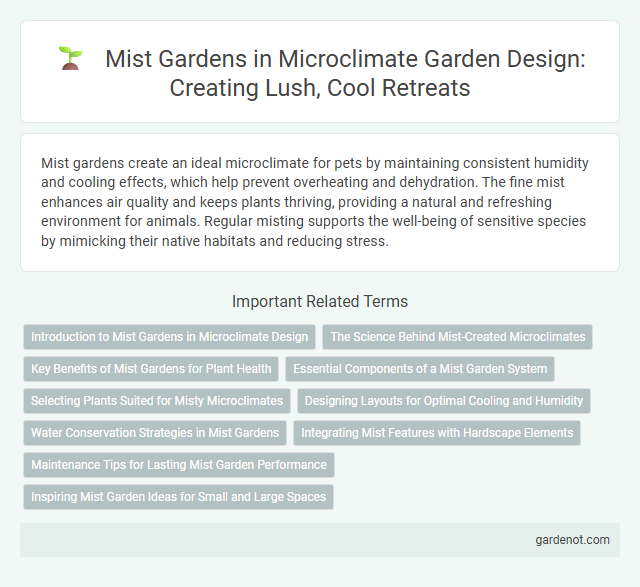Mist gardens create an ideal microclimate for pets by maintaining consistent humidity and cooling effects, which help prevent overheating and dehydration. The fine mist enhances air quality and keeps plants thriving, providing a natural and refreshing environment for animals. Regular misting supports the well-being of sensitive species by mimicking their native habitats and reducing stress.
Introduction to Mist Gardens in Microclimate Design
Mist gardens in microclimate design create cooling effects through fine water droplets that enhance humidity and reduce ambient temperature. These gardens leverage misting systems to support plant health, promote evaporative cooling, and improve air quality in confined spaces. Integrating mist gardens strategically enhances urban microclimates by mitigating heat islands and fostering comfortable outdoor environments.
The Science Behind Mist-Created Microclimates
Mist gardens utilize fine water droplets to regulate local humidity and temperature, creating a microclimate that supports delicate plant species and reduces heat stress. The mist increases air moisture through evaporation, which cools the surrounding environment and enhances transpiration and photosynthesis in plants. This scientifically controlled microenvironment promotes healthier growth and conserves water by minimizing evaporation from soil and foliage.
Key Benefits of Mist Gardens for Plant Health
Mist gardens enhance plant health by maintaining optimal humidity levels, reducing water stress and promoting vigorous growth. Fine misting improves photosynthesis efficiency by cooling leaves and preventing overheating in hot climates. Consistent moisture from mist reduces pest infestations and fungal diseases, fostering a healthier microclimate for diverse plant species.
Essential Components of a Mist Garden System
A mist garden system relies on key components such as high-pressure misting nozzles that atomize water into fine droplets, ensuring efficient cooling and humidity control. A reliable water pump and filtration unit maintain consistent mist output and prevent clogging, while a timer or automated controller regulates mist intervals to optimize plant health and water usage. Proper placement of nozzles and pressure maintenance are essential for creating a uniform mist environment critical to microclimate stability in garden areas.
Selecting Plants Suited for Misty Microclimates
Selecting plants suited for misty microclimates involves choosing species that thrive in consistently high humidity and reduced sunlight conditions. Ferns, mosses, and moisture-loving tropical plants like Calatheas and Begonias are ideal, as they absorb moisture efficiently and resist fungal diseases common in damp environments. Incorporating these plants ensures a lush, vibrant mist garden that maintains balanced moisture levels and supports diverse micro-ecosystems.
Designing Layouts for Optimal Cooling and Humidity
Designing layouts for mist gardens involves strategic placement of misting systems near dense foliage and seating areas to maximize localized cooling and humidity control. Incorporating pathways that encourage airflow while allowing mist to linger enhances the microclimate, promoting plant health and visitor comfort. Selecting drought-resistant plants and integrating water-efficient mist emitters ensures sustainability while maintaining optimal garden moisture levels.
Water Conservation Strategies in Mist Gardens
Mist gardens employ advanced water conservation strategies by utilizing fine mist sprays that significantly reduce water usage compared to traditional irrigation methods. These systems deliver water directly to plant roots and leaves in controlled amounts, minimizing evaporation and runoff. Integration of sensor technology further optimizes water distribution, ensuring efficient resource management in mist garden environments.
Integrating Mist Features with Hardscape Elements
Integrating mist features with hardscape elements in a microclimate garden enhances both aesthetic appeal and environmental comfort by cooling outdoor spaces and increasing humidity levels. Strategically placed misting systems around stone pathways, pergolas, and seating areas create refreshing zones while highlighting architectural textures and materials. This combination supports plant health by maintaining moisture and provides a sensory experience through the visual and tactile effects of softly dispersed water droplets.
Maintenance Tips for Lasting Mist Garden Performance
Regularly clean mist nozzles to prevent clogging and ensure consistent water distribution, promoting optimal humidity levels for plants. Use filtered water to reduce mineral buildup and extend the lifespan of misting components. Inspect and adjust misting schedules based on seasonal changes to maintain ideal moisture conditions and overall garden health.
Inspiring Mist Garden Ideas for Small and Large Spaces
Mist gardens transform both small patios and expansive backyards into serene retreats by incorporating fine water sprays that cool the air and nourish surrounding plants. Incorporating misting systems with native plants and shaded seating areas maximizes comfort and enhances the natural ambiance, creating a refreshing microclimate ideal for relaxation. Strategic placement of mist nozzles around pathways and near delicate foliage supports plant health while adding an artistic, ethereal quality to any garden size.
Mist garden Infographic

 gardenot.com
gardenot.com